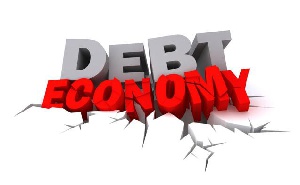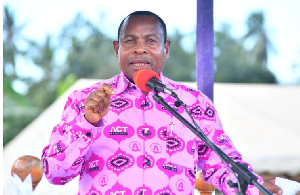Trend and Causes
Ghana’s total debt hit GH¢273.8 billion (71% of GDP) at the end-September 2020 from GH¢209.1 billion (62.4% of GDP) in September 2019, indicating an increase of GH¢64.7 billion (30.9%) in one year.
Domestic debt increased from GH¢101.4 billion (29% of GDP) to GH¢135.3 billion (35.1% of GDP) during the period, indicating an increase of GH¢33.9 billion (33.4%) and a share of 49.4%, slightly higher than the 48.5% share a year ago.
The external debt increased from GH¢107.7 billion (30.8% of GDP) to GH¢138.5 billion (35.9% of GDP) over the one-year period ending in September 2020, also indicating an increase of GH¢30.8 billion (28.6%) and a share of 50.6% over the period. (Bank of Ghana, November 2020).
According to the Bank of Ghana, the higher share of external debt over the past year ending September 2020 reflects mainly the Eurobond issuance in February this year, World Bank Development Policy Operations and support for COVID-19 Preparedness and Response Program, the IMF Rapid Credit Facility and support from the African Development Bank (September 2020).
The increase in the domestic debt reflects mainly a pick-up in the medium-to-long-term debt as the Government attempts to close the financing gap created by the COVID-19 pandemic.
Government fiscal operations in the first nine months of 2020 and the resultant sharp rise in the public debt has largely been influenced by the COVID-19 pandemic.
According to the Government, the fiscal impact of the covid-19 pandemic was estimated at GH¢9.5 billion (2.5% of GDP) in March this year, resulting from shortfalls in petroleum receipts, import duties, and other tax revenues, the cost of the Emergency Preparedness Response Plan, and the cost of the Coronavirus Alleviation Program.
The revised estimate of the fiscal impact of the pandemic indicates that total revenue and grants are expected to fall short of the 2020 budget target by GH¢13.4 billion (3.5% of GDP) whilst expenditures are expected to increase by GH¢11.8 billion (3.1% of GDP).
The overall fiscal deficit is therefore projected to increase from the original GH¢18.9 billion (5.1% of GDP) to GH¢44.1 billion (11.8% of GDP), caused by the inevitable increases in health-related costs, social interventions to protect Ghanaians from the adverse effect of the public policy responses introduced to curb the spread of the pandemic and spending on business stimulus to stop the economy from sliding into recession.
This will be a difficult task to accomplish as public spending during the last quarter of the year is expected to be bloated by the cost of holding the 2020 general elections.
Ghana’s debt stock rose by GH¢55.6 billion during the first nine months of this year and is planned to increase further by the end of 2020 as the government plans to issue a gross amount of GH¢22.7 billion in the last quarter of the year. Of this amount, GH¢19.7 billion is to be used to rollover maturities and the remaining GH¢3.0 billion as fresh issuance to meet financing requirements.
With the fiscal deficit targeted at 11.4% of GDP, which is more than twice the 4.7% of GDP deficit envisaged in the 2020 budget before the COVID 19 pandemic erupted, the government may be forced to accept bids beyond the target established in the debt issuance calendar.
In addition, on 30 September, 2020, the Minister for Finance signed on behalf of the Government two financial agreements worth €92.9 million with the European Union to support covid-19 response in Ghana and electoral violence prevention and support to enhance security in the northern border regions of the country.
In addition, on 10 November, 2020, the World Bank approved an additional credit of $130 million from the IDA for Ghana’s COVID-19 Emergency Preparedness and Response Project. This additional financing for the health sector is meant to support the Government to scale up its efforts to mitigate the resurgence of the COVID-19 pandemic and to safely reopen the economy.
All this additional financing will add to the country’s debt stock and cause it to rise beyond the 71% of GDP recorded in September this year.
In the budget sent to Parliament by the Minister of Finance on 28 October 2020 for approval as the appropriation to finance activities in the first quarter of 2021, GH¢7.0 billion is budgeted to be used to pay interest on public debt during the period.
Together with GH¢3.4 billion allocated for debt amortization, this brings debt servicing during the first quarter of 2021 to GH¢10.4 billion (2.4% of GDP).
Public finance analysts are now projecting debt service costs to take away between 40-45% of domestic revenue for the full year 2021.
Ghana’s capacity to service its debt has become weak because of its inability to mobilize enough domestic revenue to finance its activities.
Impact and Sustainability
The impact of the rising debt is also felt on the country’s debt-servicing bill. As a result of the rising public debt, the government has revised upwards interest payments in 2020 by 21.1%, from GH¢21.7 billion (5.6% of GDP) to GH¢26.3 billion (6.8% of GDP), reflecting the effect of higher borrowing to meet the additional COVID-19 related and other expenditures. In relation to total domestic revenue, interest payments on government debt is projected to increase to 50.1% in 2020 from 37.1% in 2019.
Together with wages and salaries, expenditure on the two items will amount to 101.7% of domestic revenue. This implies that domestic revenue will be insufficient to meet government’s obligations relating to interest payments, wages and salaries, pointing to the weak domestic revenue mobilization and high rigidity in the execution of the budget. Strong revenue mobilization has therefore become very critical and tax compliance needs to be strengthened.
The surge in Ghana’s public debt has also caused much anxiety about its sustainability. The public debt of 71% of GDP at the end of September 2020 passed the generally accepted sustainability threshold of 70% of GDP, raising concerns about a looming debt crisis.
According to the IMF’s Sub Saharan Africa Regional Economic Outlook Report released on October 27, Ghana’s debt-GDP ratio will rise to 76.7% of GDP by the end of 2020, posing a serious threat to both the fiscal and monetary management and putting the country at a high risk of debt distress.
Indeed, the rapid pace of the increase in the recent debt build-up and associated debt servicing costs have become a matter of serious concern.
Although Ghana’s gross international reserves as at October this year were enough to cover 4.1 months of imports, reflecting the country’s improved external position, debt sustainability issues could persuade investors to demand a risk premium when government goes to the market to issue Eurobonds.
If that happens, government will have to choose between borrowing enough to refinance existing debt or just take what it needs for budgetary support (Imirhe, 2020). In addition, the high share of foreign-currency debt, accounting for 52% of total debt, exposes the country to swings in global market conditions.
These issues have led the World Bank and the International Monetary Fund to express worry about the quantum of money being borrowed by the country. Ratings agency, Fitch, recently warned Ghana that its sovereign credit ratings may be downgraded to negative if large fiscal deficit and public debt are not addressed.
Some economists are of the view that poorer countries have no option but to borrow to develop. To them, with Ghana’s debt-to GDP ratio expected to hit 76.7% by the end of the year, the country is not borrowing too much for it to be said that it has become a debt distress country.
The fact of the matter, however, is that although public debt tends to serve as an economic stimulus by helping countries to fund development projects, rising public debt can lead to a deep financial crisis. A continuous rise in debt can cause investors to lose confidence in the country’s ability to pay back borrowed funds.
Investors will then tend to demand higher interest rates on the debt which would reduce the market value of outstanding government bonds, causing losses for investors and possibly deepen a much wider financial crisis for the country.
Conclusion and Recommendations
Public debt in many instances acts like a double edged sword. It can improve the wellbeing of the citizens when prudently used and can lead to the collapse of an economy when it is in excess or imprudently managed. Uncontrolled levels of public debt beyond a certain ratio can subject the economy to more and severe financial crises.
In Ghana’s situation, the huge borrowings over the years have been expected to generate higher returns from the projects financed with the funds. Unfortunately, borrowed funds have not been invested in productive and commercially viable ventures capable of generating enough economic returns which could be used to service the debt and eventually pay back the debt.
Elections-related fiscal slippages have also led to deep holes in government budgets and unfavorable debt issuances, and the year 2020 will not be an exception.
Indeed, in times of pandemic, the government has to do whatever it takes to save lives and protect livelihoods by spending on additional health and emergency services, support businesses and workers.
A broad-based fiscal stimulus thus becomes necessary to support the recovery. Indeed, hundreds of billions of dollars are needed to provide critical services that can help sustain lives and livelihoods and eliminate poverty.
Debt financing is therefore crucial for development and Ghana needs to find a way to prudently take on debt to recover and grow. Ghana, however, needs to develop a sound macroeconomic framework and maintain prudent fiscal policies that safeguard fiscal and public debt sustainability.
The country has to improve the composition and profile of the public debt under an appropriate medium-term debt management strategy. Government should also lock in low interest rates with modest amortization over long maturities, while smoothing the maturity profile of the entire public debt portfolio to minimize rollover risks.
The COVID-19 pandemic has been the worst crisis in Ghana in recent times, and it will require significant policy innovation to recover from the calamity. The recovery from the crisis is likely to be long and uneven, requiring strong fiscal and monetary policy support.
Government will need to prioritize critical spending on health and transfers to the poor to protect lives and support livelihoods. Policies should therefore be designed with the view to placing the economy on the path of stronger, equitable and sustainable growth.
The easing of monetary policy, while important for the recovery, should be supported with measures to prevent a build-up of financial risks over the medium term. Increased fiscal spending in the face of slow output growth will drive the public debt level to a record high. Investment in health, digital infrastructure, and education is necessary to help achieve productive, inclusive, and sustainable growth.
Government has to ensure that the debt management framework and strategies reflect the structure of the debt and take bold steps to strengthen governance around domestic revenue mobilization. In all these, what is needed is government processes that are transparent and where data and information are made available throughout the project lifecycle to help detect corrupt practices.
Ghana, through the leaders, policymakers and citizens, must find the political will necessary to insist on prudence in debt management and transparency in borrowing that are necessary to avoid the pitfalls of excessive debt.
Lack of transparency surrounding some government transactions creates additional uncertainty and risk and should be avoided.
Business News of Thursday, 10 December 2020
Source: prof. newman kwadwo kusi (ifs), ghana













